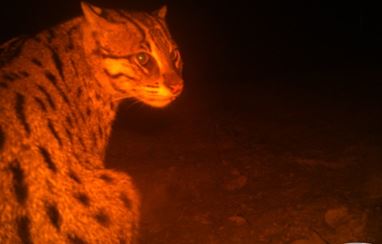Bhubaneswar: India’s oldest Ramsar Site got Fishing Cat as ambassador during Wildlife Week, 2020.
Chilika Development Authority (CDA) has designated this as its new ambassador in a meeting held to conclude the ongoing wildlife week.
The largest brackish water lagoon in Asia and India’s oldest Ramsar Site, Chilika, has an ambassador – the only wild cat species in India that is a wetland specialist – the Fishing Cat.
The globally endangered felid was found to be present all around Chilika but the marshlands fringing its north and north-eastern sections was where most evidence of its occurrence was found according to a recently concluded study.
The study was conducted by the Fishing Cat Project (TFCP) and the Indian wing of Fishing Cat Conservation Alliance (FCCA), a global organisation comprising experts working on the elusive but rare feline in all range countries in collaboration with the Chilika Development Authority (CDA), monitoring the health and well-being of the Ramsar site.
The future plans of this collaborative venture between CDA and TFCP includes regularizing protocols to estimate Fishing Cat populations in Chilika and to create a Fishing Cat conservation network by involving local stakeholders, college students, researchers, non-government and government organisations.
Fishing Cat is a Schedule I species and deserves conservation measures of the highest accord in India like the Tiger and Elephant.
Unfortunately, marshland and mangrove ecosystems, which are Fishing Cat habitat are in decline. CDA will be according highest priority in conserving the habitat and its population in future.
Chilika has one of the country’s largest extensive marsh-ecosystem spanning around 100 sq km.
Welcoming CDA’s proposition, Tiasa Adhya, co-founder of The Fishing Cat Project says, “Projecting Fishing Cat as the face of marshlands will raise the profile of Fishing Cat and marshland ecosystems globally and nationally which are otherwise neglected ecosystems. Locally, it will nurture their value among multiple stakeholders in Chilika.”
These marshes receive the maximum freshwater flow from the tributaries of Mahanadi and seasonal rivulets. Analysis of long-term data collected by Chilika Development Authority (CDA) shows that this area also has high fish abundance.
This is significant given that fish is the lifeline of Chilika sustaining 2 lakh fishermen families and globally threatened piscivorous mammals like Fishing Cat, Smooth-coated Otter and Eurasian Otter.
“Management interventions are required to prolong the life of this marshland so that it can continue to provide for the globally endangered Fishing Cat, the hundreds of precious birdlife that arrive every winter here and to the indigenous fishing community,” says Partha Dey, co-founder, TFCP .
CDA plans to manage the marshes with a socio-ecological approach involving local stakeholders and ecologists.
Estimation of Fishing Cat population will be done through camera trap in near future collaboratively by CDA, Fishing Cat Project (TFCP) and the Indian wing of Fishing Cat Conservation Alliance (FCCA).
The results are expected in the first part of 2021 and will be first of its kind in estimating the apex predator of the coastal ecosystem.
It has also been decided by CDA to have a rescue and rehabilitation centre for birds, Irrawaddy dolphins, fishing cat and otters with the help of WTI (Wildlife Trust of India) inside the Chilika lagoon.
This centre will cater to a long-standing need for rescue and rehabilitation of the migratory birds and other flagship species of the lagoon.
 Update Odisha-Latest Odisha News I Breaking News Get latest news on Odisha, Govt. Jobs, OSSC, OPSC, Entertainment, Crime, Sports, and Education
Update Odisha-Latest Odisha News I Breaking News Get latest news on Odisha, Govt. Jobs, OSSC, OPSC, Entertainment, Crime, Sports, and Education



